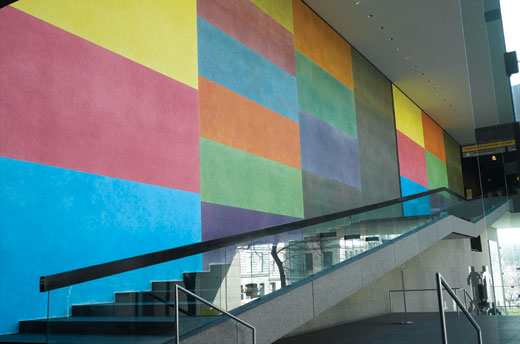
The recreation of Sol LeWitt's 1980s wall drawings, shown here nearly complete, adds new life to a main entrance of the museum.
(C) 2007 Estate of Sol LeWitt/Artists Rights Society (ARS), New York. Photo: Ric evans
Sol LeWitt Wall Drawings
By: Julie Hannon
A giant splash of color—a vibrant, dominating block of hues that makes one literally stop and take notice—has been added to the wall alongside the staircase leading up to Carnegie Museum of Art’s second-floor Scaife Galleries. And it’s causing more than the occasional rubber-necking, especially by frequent museum goers.
The attention-getter is not new, but like any aging beauty with a fresh facelift, it certainly is turning heads. Repainted over six weeks in March and April were two side-by-side Sol LeWitt wall drawings, one was a gift from Richard M. Scaife to honor Margaret R. Battle, the other donated by the artist. Almost a continuous pair, the drawings are separated only by a simple, impeccably straight black line of paint; many assume it’s a single work. But LeWitt, a critical figure in the contemporary art world’s shift to conceptual art in the 1960s, designed the second work once he saw the location of the first.
“What’s especially fun and interesting about this work is it changes with its environment and its environment changes it,” says Chantal Bernicky, a conservation fellow at Carnegie Museum of Art and one of 10 artists who contributed to the repainting.
The large drawings face the museum’s sunny Sculpture Court, luring visitors inside but also fading dramatically in the natural light over 22 years—so much so that, during the repainting, draftsman Sarah Heinemann mistook a yellow section for grey. Its colors also change depending on the angle from which and time of day you view them.
The works are titled Wall Drawing #450, A wall is divided vertically into four equal parts. All one-, two-, three- and four-part combinations of four colors, 1985 and Wall Drawing #493, The wall is divided vertically into three equal parts. All one-, two-, and three-part combinations of three colors, 1986.
Their very public and quite warm location in the springtime—on a few days, temperatures climbed above 100 degrees—made the project no easy task for the artists. Add to that scaffolding tall enough to reach the immense 136-by-29-foot drawings and the work being book-ended by a floor-to-ceiling glass window, and it makes the job that much more impressive.
Led by Heinemann—a member of LeWitt’s studio who travels the world executing his drawings—a team of local artists followed simple but precise pencil-drawn instructions from 1985 and 1986. That’s how LeWitt worked: He created art by developing an idea and producing written instructions for other artists, many trained in his studio, to carry out. He believed the input of others was part of the process, and even children have contributed to some of his public works in schools. So each drawing is different—even repainted works change. While the application method of the paint is rigid and precise, it’s always someone new working the paint rags. And items such as paint primer are different—more or less porous—in North America compared to products in Europe and Asia, making a difference in the outcome.
After artists primed the walls using a technique to create a surface that resembles the peel of an orange, and then precisely mapped out shapes in pencil and tape, the crew followed simple instructions: apply mixtures of red, blue, yellow, black and gray with rags. But this time, they used lightfast acrylic paint, expected to last much longer than the original ink wash.
“Each shape is an accumulation of one to four layers of color. Each layer consists in three applications of a specific color of paint” explains Bernicky. “The idea was to apply paint as evenly as possible with no patterns. This meant four or five of us working together on the same shape at one time.”
The work took on special meaning when LeWitt died April 8 at the age of 78, near the end of the project. Also contributing to the renovation were museum staff members Dale Luce, a preparatory and artist, and Julia McAfee, a security guard and artist, as well as local artists Matthew Cummings, Cara Erskine, Robin Hewlett, Lilith Bailey Kroll, Sandra Streiff, and Stephen Stribling.
|
 Summer 2007
Summer 2007

